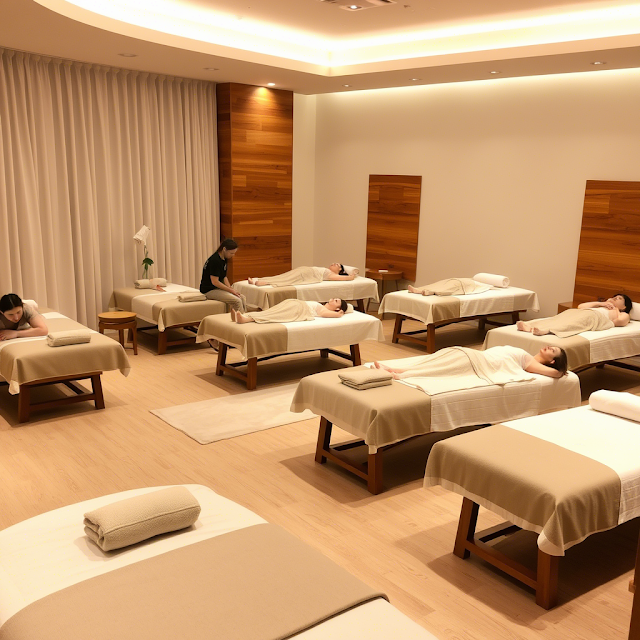massage room
A massage room is a designated space specifically designed for providing massage therapy or bodywork treatments. These rooms are typically tranquil, comfortable, and equipped with the necessary tools and furniture to facilitate relaxation and healing. Whether in a spa, wellness center, or private practice, the massage room should create an atmosphere that promotes calmness and rejuvenation.
Here are some key features and elements of an ideal massage room:
1. Ambiance
- Lighting : Soft, dim lighting is essential to create a relaxing environment. Many massage rooms use candles, Himalayan salt lamps, or soft LED lights to enhance the calming atmosphere.
- Scent : Aromatherapy is often incorporated through the use of essential oils like lavender, eucalyptus, or chamomile to promote relaxation and stress relief.
- Sound : Gentle background music or nature sounds (e.g., ocean waves, rain, or birdsong) help to block out external noise and create a peaceful setting.
2. Furniture & Equipment
- Massage Table : The centerpiece of any massage room is the massage table. It should be adjustable, padded, and covered with clean, soft linens. Some tables come with face cradles for client comfort.
- Stools & Chairs : Therapists may need a stool or chair to sit on during certain types of massage (e.g., reflexology or seated massage).
- Side Table : A small side table or tray is useful for holding oils, lotions, creams, or other tools the therapist may need during the session.
- Storage : Cabinets or shelves are often included to store towels, linens, oils, and other supplies.
3. Temperature Control
- Heating : The room should be warm enough to keep clients comfortable while they are undressed and lying on the table. Heated blankets or bolsters can also be used.
- Ventilation : Proper ventilation is important to ensure fresh air circulation, but it should be subtle so as not to disrupt the serene environment.
4. Decor
- Colors : Neutral, earthy tones like beige, soft green, or light blue are often used in massage rooms because they evoke feelings of calm and relaxation.
- Plants : Adding live plants or flowers can enhance the natural, soothing vibe of the room.
- Artwork : Minimalist, nature-inspired artwork or mandalas can contribute to the tranquil atmosphere without overwhelming the senses.
5. Hygiene & Cleanliness
- Clean Linens : Fresh sheets, pillowcases, and towels should be used for each client. The room should be thoroughly cleaned and sanitized between sessions.
- Disinfectants : All surfaces, including the massage table, should be disinfected regularly to maintain hygiene standards.
- Disposable Items : Items like paper covers for the massage table, disposable slippers, or robes can be provided for added cleanliness.
6. Privacy
- Doors & Curtains : The massage room should have a lockable door or a curtain to ensure privacy for the client while they undress and dress.
- Soundproofing : If possible, the room should be soundproofed to minimize external noise and distractions.
7. Additional Amenities
- Robes & Slippers : Some massage rooms offer robes, slippers, or disposable underwear for clients to change into.
- Water Station : A small water station or cooler with fresh water is often available for clients to hydrate before or after their session.
- Hot Towels : Warm, damp towels may be offered at the end of the session to refresh the client's face or hands.
Types of Massage Rooms:
- Spa Massage Room : Typically more luxurious, with additional amenities like steam showers, saunas, or hot tubs nearby.
- Private Practice Room : Often simpler, focusing on functionality and comfort for one-on-one sessions.
- Mobile Massage Setup : For therapists who travel, a portable massage table and compact equipment are used to create a temporary massage space in the client’s home or office.
Conclusion:
A well-designed massage room is crucial for creating a serene and therapeutic environment. Attention to detail in terms of ambiance, equipment, cleanliness, and comfort ensures that clients feel relaxed and cared for, allowing them to fully benefit from the massage experience.
แปล
ห้องนวดเป็นพื้นที่ที่ออกแบบมาโดยเฉพาะสำหรับการบำบัดด้วยการนวดหรือการบำบัดด้วยการนวดตัว ห้องเหล่านี้มักจะเงียบสงบ สะดวกสบาย และมีเครื่องมือและเฟอร์นิเจอร์ที่จำเป็นเพื่อการผ่อนคลายและบำบัด ไม่ว่าจะเป็นในสปา ศูนย์สุขภาพ หรือคลินิกส่วนตัว ห้องนวดควรสร้างบรรยากาศที่ส่งเสริมความสงบและการฟื้นฟู ต่อไปนี้คือคุณสมบัติและองค์ประกอบหลักบางประการของห้องนวดในอุดมคติ: 1. บรรยากาศ แสงไฟ: แสงไฟสลัวๆ เป็นสิ่งสำคัญในการสร้างสภาพแวดล้อมที่ผ่อนคลาย ห้องนวดหลายแห่งใช้เทียน โคมไฟเกลือหิมาลัย หรือไฟ LED อ่อนๆ เพื่อเพิ่มบรรยากาศที่ผ่อนคลาย กลิ่น: มักจะใช้กลิ่นหอมจากน้ำมันหอมระเหย เช่น ลาเวนเดอร์ ยูคาลิปตัส หรือคาโมมายล์ เพื่อส่งเสริมการผ่อนคลายและบรรเทาความเครียด เสียง: ดนตรีประกอบที่นุ่มนวลหรือเสียงธรรมชาติ (เช่น คลื่นทะเล ฝน หรือเสียงนกร้อง) ช่วยปิดกั้นเสียงรบกวนจากภายนอกและสร้างบรรยากาศที่เงียบสงบ 2. เฟอร์นิเจอร์และอุปกรณ์ โต๊ะนวด: จุดศูนย์กลางของห้องนวดคือโต๊ะนวด ควรปรับได้ มีเบาะรองนั่ง และปูด้วยผ้าปูเตียงที่สะอาดและนุ่ม โต๊ะบางตัวมีที่รองหน้าสำหรับรองรับใบหน้าเพื่อความสบายของลูกค้า เก้าอี้และม้านั่ง: นักบำบัดอาจต้องการเก้าอี้หรือม้านั่งสำหรับนั่งระหว่างการนวดบางประเภท (เช่น รีเฟลกโซโลยีหรือการนวดแบบนั่ง) โต๊ะข้าง: โต๊ะข้างขนาดเล็กหรือถาดมีประโยชน์สำหรับวางน้ำมัน โลชั่น ครีม หรืออุปกรณ์อื่นๆ ที่นักบำบัดอาจต้องใช้ระหว่างการนวด การจัดเก็บ: มักจะมีตู้หรือชั้นวางของสำหรับเก็บผ้าขนหนู ผ้าปูที่นอน น้ำมัน และของใช้อื่นๆ 3. การควบคุมอุณหภูมิ ระบบทำความร้อน: ห้องควรอบอุ่นเพียงพอที่จะทำให้ลูกค้ารู้สึกสบายตัวในขณะที่ถอดเสื้อผ้าและนอนอยู่บนโต๊ะ สามารถใช้ผ้าห่มหรือหมอนอิงอุ่นๆ ได้เช่นกัน การระบายอากาศ: การระบายอากาศที่เหมาะสมเป็นสิ่งสำคัญเพื่อให้แน่ใจว่าอากาศบริสุทธิ์หมุนเวียน แต่ควรระบายอากาศอย่างนุ่มนวลเพื่อไม่ให้รบกวนสภาพแวดล้อมที่เงียบสงบ 4. การตกแต่ง สี: โทนสีกลางๆ เช่น สีเบจ สีเขียวอ่อน หรือสีฟ้าอ่อน มักใช้ในห้องนวด เพราะสีเหล่านี้ทำให้รู้สึกสงบและผ่อนคลาย ต้นไม้: การเพิ่มต้นไม้หรือดอกไม้สดเข้าไปสามารถเพิ่มบรรยากาศที่เป็นธรรมชาติและผ่อนคลายให้กับห้องได้ งานศิลปะ: งานศิลปะหรือมณฑลที่เรียบง่ายซึ่งได้รับแรงบันดาลใจจากธรรมชาติสามารถช่วยให้บรรยากาศเงียบสงบโดยไม่รบกวนประสาทสัมผัส 5. สุขอนามัยและความสะอาด ผ้าปูที่นอนที่สะอาด: ควรใช้ผ้าปูที่นอน ปลอกหมอน และผ้าขนหนูใหม่สำหรับลูกค้าแต่ละคน ควรทำความสะอาดและฆ่าเชื้อห้องอย่างทั่วถึงระหว่างเซสชัน น้ำยาฆ่าเชื้อ: ควรฆ่าเชื้อพื้นผิวทั้งหมด รวมถึงเตียงนวดเป็นประจำเพื่อรักษามาตรฐานด้านสุขอนามัย สิ่งของที่ใช้แล้วทิ้ง: สามารถจัดเตรียมสิ่งของต่างๆ เช่น ปลอกกระดาษสำหรับเตียงนวด รองเท้าแตะแบบใช้แล้วทิ้ง หรือชุดคลุม เพื่อความสะอาดยิ่งขึ้น 6. ความเป็นส่วนตัว ประตูและม่าน: ห้องนวดควรมีประตูหรือม่านที่ล็อกได้เพื่อให้ลูกค้ามีความเป็นส่วนตัวในขณะที่ถอดเสื้อผ้าและแต่งตัว การเก็บเสียง: หากเป็นไปได้ ควรเก็บเสียงในห้องเพื่อลดเสียงรบกวนจากภายนอกและสิ่งรบกวนต่างๆ 7. สิ่งอำนวยความสะดวกเพิ่มเติม ชุดคลุมอาบน้ำและรองเท้าแตะ: ห้องนวดบางห้องมีชุดคลุมอาบน้ำ รองเท้าแตะ หรือชุดชั้นในแบบใช้แล้วทิ้งให้ลูกค้าเปลี่ยน จุดบริการน้ำ: มักจะมีจุดบริการน้ำขนาดเล็กหรือเครื่องทำน้ำเย็นพร้อมน้ำจืดไว้ให้ลูกค้าได้ดื่มน้ำก่อนหรือหลังการนวด ผ้าขนหนูอุ่น: อาจมีผ้าขนหนูชื้นอุ่นไว้ให้บริการในตอนท้ายการนวดเพื่อให้ใบหน้าหรือมือของลูกค้าสดชื่นขึ้น ประเภทของห้องนวด: ห้องนวดสปา: มักจะหรูหราขึ้น โดยมีสิ่งอำนวยความสะดวกเพิ่มเติม เช่น ห้องอบไอน้ำ ห้องซาวน่า หรืออ่างน้ำร้อนอยู่ใกล้ๆ ห้องนวดส่วนตัว: มักจะเรียบง่ายขึ้น โดยเน้นที่การใช้งานและความสบายสำหรับการนวดแบบตัวต่อตัว การตั้งค่าการนวดแบบเคลื่อนที่: สำหรับนักบำบัดที่ต้องเดินทาง จะใช้โต๊ะนวดแบบพกพาและอุปกรณ์ขนาดกะทัดรัดเพื่อสร้างพื้นที่นวดชั่วคราวในบ้านหรือสำนักงานของลูกค้า บทสรุป: ห้องนวดที่ออกแบบมาอย่างดีมีความสำคัญอย่างยิ่งในการสร้างสภาพแวดล้อมที่เงียบสงบและบำบัดรักษา ความเอาใจใส่ในรายละเอียดในแง่ของบรรยากาศ อุปกรณ์ ความสะอาด และความสะดวกสบาย ทำให้แน่ใจว่าลูกค้ารู้สึกผ่อนคลายและได้รับการดูแล ทำให้พวกเขาได้รับประโยชน์อย่างเต็มที่จากประสบการณ์การนวด













Comments
Post a Comment